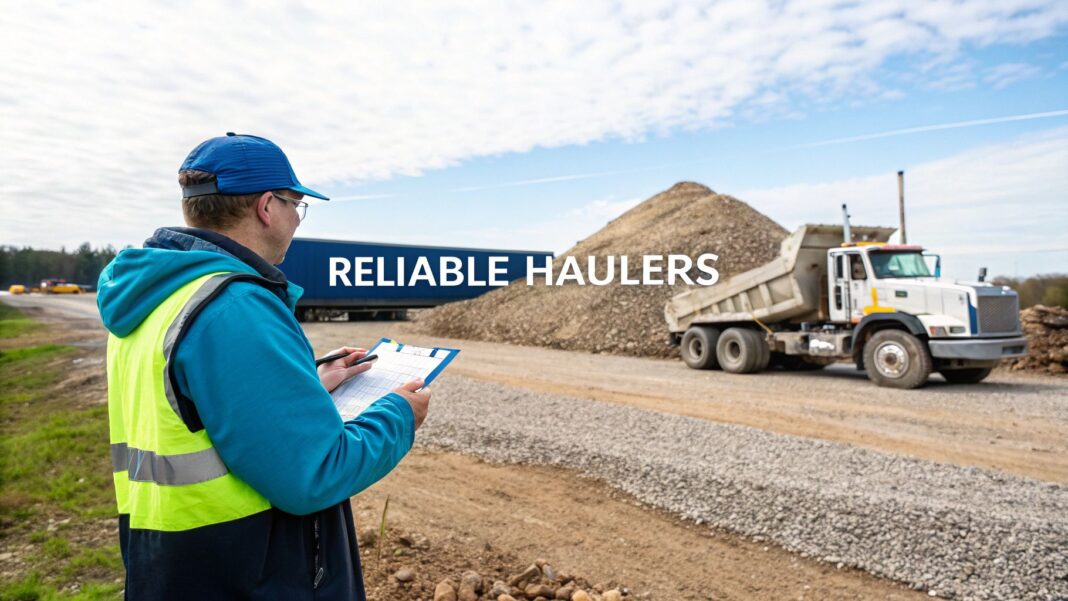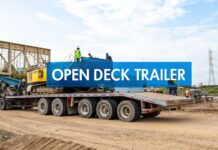
Before you search for dump truck haulers, the most critical step is defining your project scope. A detailed plan is the single best tool for getting accurate quotes, attracting professional operators, and ensuring your project runs on schedule. Vague requests lead to inflated prices and unreliable partners.
This guide provides actionable insights for managing the entire hauling process, from initial planning to final payment.
Defining Your Project for Accurate Transport Quotes
To get a precise quote, you need to provide haulers with the specific details they use to calculate their costs and logistics. A comprehensive brief shows you are a serious client, which attracts higher-quality transport partners.
First, identify the material you are moving. Is it clean fill, demolition debris, sand, or a specific aggregate? The material type determines the weight per volume, which dictates the appropriate truck size and type needed. Next, calculate the total volume in cubic yards or tonnage. This estimate allows the hauler to determine the number of trucks required and the total trips needed to complete the job.
Nail Down the Transport Logistics
Once you know what you're hauling, you must define the how and where. Transport logistics are just as critical as the material itself. You need precise pickup and drop-off addresses and a clear understanding of potential site challenges.
Assess these key logistical factors:
- Site Access: Are there tight turns, low-hanging power lines, or narrow gates that could obstruct a large truck? Provide photos or diagrams if possible.
- Ground Conditions: Is the terrain paved, soft dirt, or gravel? Will recent weather (like rain) create mud? Are there steep grades that require specific truck capabilities?
- Operational Hours: Are there site-specific noise restrictions or designated work hours?
Answering these questions upfront prevents costly delays. For instance, informing a hauler about soft ground allows them to dispatch an all-wheel-drive truck instead of a standard tandem axle that would get stuck. When dealing with complex projects, understanding the full scope of construction equipment transport provides valuable perspective on coordinating multiple vehicle types.
A detailed transport plan not only secures a better price but also establishes a foundation of professionalism and respect with your hauling partner from day one.
Use the following checklist to gather the essential details every hauler needs for an accurate quote.
Key Project Details for Accurate Hauling Quotes
Use this checklist to gather the essential information haulers need to provide a precise quote and ensure smooth operations.
| Information Category | Specific Details to Define | Why It Matters for Your Quote |
|---|---|---|
| Material Details | Type (e.g., topsoil, gravel, concrete), estimated volume (cubic yards), or weight (tons). | Determines the type and size of dump truck required and the total number of trips. |
| Site Locations | Exact pickup and drop-off addresses. | Calculates travel time, distance, and fuel costs—a major component of your price. |
| Site Conditions | Access (tight turns, gates), ground (paved, mud, steep), potential obstacles. | Informs the hauler about potential risks or the need for specialized equipment (e.g., AWD trucks). |
| Project Timeline | Start date, end date, and required daily hours of operation. | Affects scheduling, truck availability, and whether overtime rates might apply. |
| On-Site Contacts | Name and phone number for the site supervisor or point person. | Ensures smooth communication for arrivals, departures, and any on-the-spot issues. |
Having these details prepared before you contact haulers will streamline the hiring process and lead to more effective cost management.
Of course, your hauling budget is part of the larger project funding. For significant jobs, securing financing for construction projects is a critical prerequisite. The global dump truck market was valued at around USD 63.75 billion in 2025 and continues to grow, reflecting its importance in the construction industry.
How to Vet and Select Your Hauling Partner
Selecting the right dump truck hauler requires more than a simple online search. This decision directly impacts your project's timeline and budget. You are looking for a reliable transport partner, not just a driver with a truck.
The first, non-negotiable step is to verify their credentials. Request a current Certificate of Insurance (COI) to confirm they have adequate coverage. Next, use their USDOT number to check their safety record and compliance history online. This public information provides a transparent view of their operational standards.
Dig Deeper Than the Basics
Once you've confirmed their legitimacy, determine if they are the right fit for your specific job. Ask for references from clients with similar projects—this is the best indicator of their performance. Inquire about their experience hauling your specific material or navigating comparable site conditions.
For particularly large or specialized loads, you might need a company with more specific expertise. Our guide on heavy haulers is a great resource if you're moving something out of the ordinary: https://www.wewilltransportit.com/services/heavy-haulers/
When speaking with potential partners, ask targeted operational questions:
- What types of trucks are in their fleet (e.g., semi-end dump, tri-axle), and which is best for your material?
- What is their contingency plan for equipment breakdowns to prevent project delays?
- What is their standard scheduling lead time?
If a company is hesitant to provide documentation or gives vague answers, consider it a major red flag. Transparency is essential for a successful transport partnership.
Before starting these conversations, ensure your own project details are finalized. This infographic outlines the essential information to have ready.
Knowing your material, volume, and site logistics allows you to find a hauler who is truly equipped for your project.
Understand the Regulatory Landscape
Familiarize yourself with the regulations governing dump truck operations. A basic understanding of DOT Regulations for Dump Trucks helps you ask intelligent questions and identify potential compliance issues.
With massive investments in construction and infrastructure, the need for qualified haulers is at an all-time high. The global dump truck market was valued at around USD 22.8 billion in 2025 and is expected to more than double to USD 54.0 billion by 2035. This growth makes it critical to select an experienced, compliant professional.
Don't Skip the Handshake: Put Your Hauling Agreement in Writing
A verbal agreement for a hauling job is a significant business risk. A clear, written contract is a professional necessity that protects both you and your hauler by establishing clear expectations from the outset. This document serves as the project’s single source of truth, preventing misunderstandings that lead to delays, payment disputes, and damaged business relationships.
Nail Down the Scope and Payment Details
Your contract must precisely define the scope of work. Avoid vague terms like "haul dirt."
Instead, provide specific details:
- The number of trucks required.
- The expected daily hours of operation.
- The exact type of material being transported.
- The specific pickup and drop-off locations.
Equally important is defining the pricing model. Spell out the payment structure clearly. The most common arrangements are:
- Per Hour: Best for jobs with anticipated on-site wait times or complex loading scenarios.
- Per Ton: Ideal when billing is based on the exact weight of the material.
- Per Load: A simple flat rate suitable for repetitive, point-A-to-point-B transport.
Once the rate is established, define your payment terms. Specify the invoicing schedule (e.g., weekly, bi-weekly, upon completion), due dates, and accepted payment methods. This clarity prevents financial misunderstandings later.
A solid agreement isn't built on mistrust. It's built on a shared understanding of what a successful job looks like. When everyone knows the rules, you can all get to work.
Plan for When Things Go Sideways
Even the best-planned projects encounter unexpected issues. A practical hauling agreement anticipates potential problems.
Include clauses that cover contingencies. What is the protocol for weather delays? How will they be communicated, and how does the schedule adjust? You must also address excessive on-site wait times. Specify if a standby rate applies after a certain duration (e.g., one hour) of waiting.
Finally, clearly assign liability for potential damages to property, equipment, or personnel. Addressing these scenarios in writing before they occur is the mark of a professional and is key to keeping the project on track.
Getting On-Site Logistics and Communication Right
Effective on-site coordination is critical for a smooth-running project. Poor logistics can cause immediate bottlenecks and delays. Success depends on clear communication and strategic site planning.
First, establish a single on-site point of contact. Your haulers must know exactly who to report to and who to contact with questions. Conflicting orders from multiple supervisors lead to confusion and lost time. Next, implement a daily communication rhythm. A brief morning huddle or a group text can align the team on the day’s plan and identify potential obstacles.
Planning Your Site Layout
The physical management of your site is as crucial as communication. You must map out efficient and safe traffic flow for all trucks. A poorly planned route creates bottlenecks, wastes fuel and time, and increases accident risk.
Address these key areas before the first truck arrives:
- Entry and Exit Routes: Ensure truck paths are clear, wide, and safe. Conduct a walk-through to identify hazards like soft ground, tight corners, or low-hanging obstacles. Use cones and signs to guide drivers.
- Loading Zones: Position your loading area for easy access. Excavator operators should not have to maneuver around other vehicles. Provide ample space for efficient loading.
- Staging Areas: If multiple trucks will be on-site simultaneously, designate a waiting area away from the main access road to prevent congestion.
Proactive coordination is what separates a chaotic job site from a productive one. Thinking through the physical flow of traffic prevents delays and keeps your entire project on schedule.
A practical tip is to schedule material deliveries during off-peak hours to avoid congestion with other contractors, like concrete trucks. On complex jobs, understanding various transport methods, like those detailed in this guide on flatbed truck trailer transport, can significantly improve your ability to manage diverse vehicle logistics.
Finalizing the Job and Handling Payments
Finishing a project professionally is as important as starting it correctly. The process of verifying work and issuing the final payment to your dump truck haulers establishes your reputation and sets the stage for future partnerships.
Before making the final payment, perform your due diligence by meticulously tracking and verifying all work performed. This is a standard business practice that protects both parties.
Cross-Checking the Paperwork and Settling Up
The most effective method for verification is to compare your records against the hauler’s invoice. Check your signed load tickets or digital tracking data against their billed hours or loads. If a discrepancy arises, your documentation will facilitate a simple, factual conversation rather than a dispute.
Once you confirm the invoice is accurate, process the payment promptly, adhering to the terms defined in your contract. Slow payment damages your reputation and can make it difficult to secure reliable dump truck haulers in the future.
Don't just pay and move on. Taking a few minutes for a post-project review can give you some serious insights for the next job and helps you build a network of go-to professionals.
Paving the Way for Future Projects
Take a moment to conduct a brief, informal performance review of the hauling service.
- Were they punctual and communicative?
- Was their equipment well-maintained and suitable for the job?
- How did their drivers handle unexpected on-site challenges?
Providing constructive feedback, both positive and negative, is a professional courtesy that strengthens business relationships. When combined with prompt payment, this practice solidifies your status as a preferred client, ensuring you have access to trusted partners for future projects.
Common Questions We Hear About Hiring Dump Truck Haulers
Here are answers to the most common questions about the hauling process, focusing on payment structures, insurance, and handling project disruptions.
How Do I Pay For This?
Pricing for dump truck services is typically structured in one of three ways:
- Per Hour: This is the best option for jobs where trucks may experience wait times due to site access or loading procedures.
- Per Load: This flat-rate model is efficient for straightforward, repetitive hauls between two set points.
- Per Ton: This method is ideal when the exact weight of the material is the primary billing factor, commonly used by quarries and material suppliers.
Before finalizing an agreement, get the pricing structure in writing. Clarify any potential additional costs, such as fuel surcharges or minimum hour requirements, to avoid budget overruns.
What's The Deal With Insurance and Liability?
Never allow a truck on your site without first verifying their Certificate of Insurance (COI).
At a minimum, the COI must list commercial auto liability and general liability coverage. For larger projects, request to be named as an "additional insured" on their policy for an extra layer of protection. Your written agreement should explicitly state who is liable for damages. Typically, the hauler’s insurance covers damage caused by their equipment or driver, which is why upfront verification is essential.
When a dump truck accident happens, figuring out who's liable can get messy fast. It could be the driver, the trucking company, or even the truck's manufacturer. A rock-solid contract is your best defense.
What About Delays and Other Problems?
Unforeseen issues like weather or equipment breakdowns are common. A proactive plan is the best way to manage them.
Your contract should detail procedures for delays. If your site is not ready for scheduled trucks, will a standby rate apply? Negotiate this term upfront. For weather delays, establish a clear communication plan for postponing work. For any site-specific problems, contact your hauler immediately. A professional partner will work with you to find a solution, but having these contingencies outlined in your contract protects all parties and helps get the project back on track quickly.
When you need reliable, professional transport for any vehicle or heavy equipment, We Will Transport It offers nationwide solutions backed by years of experience. Get your free, no-obligation quote today.





